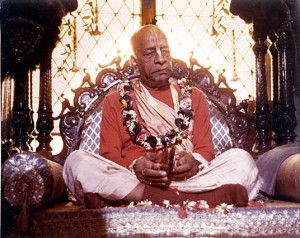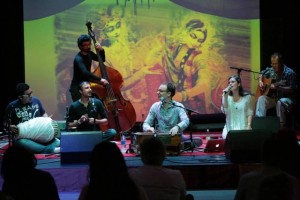This article is a compilation of several conversations between Hindu intellectuals (HI) and ISKCON scholars (IS) on various occasions. To cover the various issues in a systematic way, all these conversations are presented here as one, continuous conversation between two individuals.
HI: An issue of great concern, even alarm, is the rampant conversion done by Christian missionaries.
IS: Let’s understand this issue of conversion from a broader philosophical perspective. The goal of all religions – including Christianity – is to help people develop love of God, to convert people from being materialists to becoming spiritualists.
But different people approach God for different motives, which the Vaishnava saint-scholar Bhaktivinoda Thakura has categorized into four major levels: fear, desire, duty and love.
- Fear: Some people fear, “If I disobey God, then He may punish me for my wrongdoings. So better let me pacify Him by my worship.” This sort of worship is certainly better than atheism, but it is based on a very negative conception of God as a stern judge, as a cosmic punisher.
- Desire: Some people reason, “There are so many things I want; if I pray to God, perhaps He will give them to me.” Here the conception of God is more positive, as a potent desire-fulfiller, but still the relationship is highly utilitarian, being based on give-and-take rather than love. Srila Prabhupada would say that if we go to God to ask for bread, that shows our love for bread more than our love for God.
- Duty: Some people reason, “God has already given me so much – life, body, health, food, clothing, shelter. It is my duty to go periodically to worship and thank Him.” Here the relationship is somewhat steady being based on gratitude for what has already been given and not on greed for what one wants to receive. Still, over time, duty can become a burden. Moreover, the focus in this level is still on what God has done for me, not on God Himself.
- Love: This is the purest level of approaching God, where a person feels, “My dear Lord, You are the supreme object of my love; I have been offering my love to so many people and things, but that has never made me happy. Now I simply want to love and serve You eternally and I do not want anything material in return for my service; I simply wish to love You and to be loved by You. Just as a parent takes care of the child without the child having to ask his parents, similarly, I know that You will take care of me. I will accept whatever is Your plan for me and keep serving You no matter what happens in my material life.” It is only this pure love that can satisfy our hearts fully, for love is our greatest and deepest need.
Conversions are fruitful only if they raise a person’s level of approaching God by offering deep spiritual understanding or experience. Modern Christianity operates largely on the platforms of fear and desire – despite the fact that Jesus explicitly emphasized the commandment to love God as the supreme commandment. It appears to many observers that the conversions done by Christian missionaries today are primarily on the same two levels – fear of eternal damnation and desire for material gain. More often than not, all that happens by such materially-motivated conversions is that the converts change from being Hindu materialists to becoming Christian materialists.
HI: But this conversion often makes a huge difference to the convert’s attitude toward his original culture. Whereas he was earlier appreciative of – or at least neutral to –Indian culture, he now becomes hostile to it. And often this hostility is fostered by some Christian missionaries who decry Indic rituals and traditions as demoniac. Sometimes the convert has to “prove” his conversion by publicly disowning his past forms of worship, by breaking or burning the pictures of Hindu gods or even spitting or stamping on them.
IS: This is very unfortunate and distressing to hear about...To place this in proper perspective, let’s discuss the three categories into which modern thinkers have classified the various religious paths: exclusivist, pluralist and inclusivist.
Followers of the exclusivist path claim that their way is the only exclusive way to God. They further claim that all those who don’t accept their path are destined to go to hell – forever. So they become intolerant to all other paths and believe that they are “saving” people by converting them to their path, no matter what the means. Religious exclusivity sometimes degenerates into fundamentalist violence. This further puts off intelligent people, who are already skeptical of the claim to exclusivity. After all, if God is unlimited, why should one particular religion have monopoly on the path to God?
HI (nodding): Most Christian missionaries are highly exclusivist. Hindu culture, on the other hand, has historically been more broad-minded.
IS: Yes. The second category is pluralism. Pluralism is the notion that there are many paths to God. Nowadays, this notion is sometimes expanded to say that there are as many paths to God as there are people. While this notion seems to promote religious tolerance, it often breeds spiritual impotence.
HI (startled): Impotence?
IS: A religious system can be compared to a university meant to train students in knowledge and love of God. The claim to exclusivism is like the claim of a medical student that his college is the only college that can produce doctors. This is obviously a fanatical and fallacious claim. The claim to pluralism, on the other hand, is like the claim that any building anywhere can produce doctors. In the name of pluralism, Hinduism today has become such a hodgepodge that most Hindus today have very little idea of what paths and goals their scriptures teach. Consequently, when confronted with Christian missionary criticism of Hinduism, many Hindus are unable to defend their beliefs and practices.
HI (thoughtfully): I had never thought of the effects of pluralism in that way … I can’t say that I agree entirely with what you say; I will have to think about it…But what was the third category you mentioned?
IS: Inclusivism. This teaches that there are not many paths, but basically one path with many levels on it. The path to become a doctor is essentially one: to study the medical subjects and learn the relevant skills. There may be different universities to teach medicine and they may teach in slightly different ways, but that doesn’t mean we unthinkingly accept every building everywhere as a medical college. Unfortunately, this – an uncritical acceptance of all paths – is what has happened in India. Consequently, although religion is a big part of life in India, it has largely become reduced to a social and cultural affair that provides a break from the daily routine and has become devoid of spiritual potency.
HI: What exactly do you mean by spiritual potency?
IS: Spiritual potency of religion means it ability to deliver non-material or spiritual happiness. The Srimad Bhagavatam declares bhakti pareshanubhava viraktir anyatra ca (11.2.42) “Bhakti delivers experience of the transcendental Supreme Lord, an experience which is so satisfying, so enriching that it makes one detached from all other experiences.” The ultimate purpose of all religion is to enable people to experience the divine happiness of loving God and thus become detached from selfish, materialistic pleasures. The Vedic scriptures give clear, specific and powerful practices to help us experience this spiritual happiness. But when all paths are considered equal without evaluating their effects, then the potent Vedic path gets obscured in a medley of diluted and perverted paths. Consequently, many Indians, who follow one of these pseudo-religious paths, experience hardly any deep, spiritual happiness. So, when they are tempted to follow another path that offers tangible material benefits, they see no reason to desist.
HI: Interesting. In connection with our discussion on three categories of paths, I want to point out a peculiar feature of Indian “secularism”. Despite the overtly exclusivist claims of Christian missionaries, the Indian government and media pamper them in the name of secularism. Secularism should basically imply governmental impartiality toward all religions. In countries like USA, secularism means that minority-religions get the freedom to practice their beliefs and they democratically get a voice in the polity according to their sizes. And the majority-religion in USA – protestant Christianity – gets a respectable place and influence according to its electoral strength. But in India, due to vote bank politics, secularism is abused to provide special facilitation for minority-religions and impose special restriction on the majority religion. For example, today, in India, legally it is far easier to start a Christian church or a Christian missionary school then it is to start a Hindu temple or a Hindu missionary school. Or, here’s an even more egregious example: when Muslims want to go for Haj, the government makes special arrangements and even subsidizes their pilgrimage fare. But when Hindus want to go on pilgrimage to Badrinath, the government offers no such facility.
What makes the whole issue worse is the prejudiced media portrayal by the western media and the westernized Indian media. Historically, not many countries have been as hospitable to other cultures as India, thanks to the Hindu culture of welcoming and respecting guests as representatives of God. For example,
- India is the country that gave asylum to the Christians who were persecuted in Syria in Antioch and Damascus even in the fourth century. They have been living here peacefully till this date.
- India gave asylum to the Persians when they had to flee Persia due to fear of the Arabian invaders. These Zoroastrians who took asylum in the Gujarat area are all leading prosperous and fearless lives till this date.
- When the Jews sought asylum in India after being driven out of their land, they were taken care of by India. This was not the case with several countries in the West where the Jews were persecuted.
- After the conquest of Tibet by China, the persecuted Buddhists under the Dalai Lama generously accommodated by India in McLeod Ganja in the Himachal Pradesh, where they live peacefully even today.
So, minorities have always been given protection and facility to live in India, thanks to the Hindu ethos of tolerance. But when Hindus try to protect their legitimate interests from the extreme and fundamentalist activities of some Christian missionaries, the media immediately brands the tolerant Hindus as intolerant and the fundamentalist minorities as helpless victims. It is sad that these situations have led to violent conflicts; violence in the name of religion is unfortunate and regrettable. But the sponsoring of culturally-destructive conversion is a form of extremism that inflames violence on both sides. It is high time that the media set the record straight by reporting both sides of the story fairly.
IS: This governmental and media antipathy is aided by the intellectual lethargy of Indians in understanding their own national legacy. Indians don’t protest against attacks on their culture because they don’t realize the value of what they are losing. In academic studies of religion, there is the concept of religious capital, which refers to the degree of mastery of and attachment to a particular religious culture. A businessman may readily give up his present business if he has not invested much capital in it, if he is not getting much returns out of it and if a new business offers better prospects. Similarly, a person will change his religion – his religious business – if he has not invested much thoughts and emotions into it (his capital), if he is not getting an understanding of life or a sense of peace, joy and belonging by it (his returns) and if he gets material benefits by changing to another religion (his better prospects). So it is important for Indian spiritual leaders to create religious capital among Indians by giving them spiritual knowledge and experience. Otherwise, most Indians will not oppose conversion or, worse still, may even get converted themselves for better material prospects.
HI: Well, sometimes the idea of better prospects is just a sham. Some missionaries claim to be faith-healers and proclaim that they can cure all those who convert. Many sick Hindu peasants, being unable to afford medical expenses, get lured, but the magic healing never happens. Their suffering only gets compounded: due to the delay in taking medical treatment, they disease worsens, thus necessitating further expenditure. And they simultaneously undergo wrenching mental trauma and social alienation due to the whole conversion melodrama. Many such incidents are described the documentary Bad Manna by the Scandinavian Pia Skov, who, incidentally, is herself a Christian disillusioned with the missionary malpractices.
IS: Such practices are certainly devious – and they underscore what I was saying earlier: the urgent necessity for philosophical education among Indians. You see, many people have a primitive, tribal “we-they” mindset. They see existence as a perpetual battle between “we” versus “they”, where “they” refers to their rivals or enemies. When religious zeal becomes superimposed on this tribal mentality, then the battle takes the form of “the good we” versus “the evil they”, where “they” includes all those who don’t follow “our true religion”. Once religious conversion gets rationalized as a battle against evil, or perhaps a “saving” from the evil, then the missionaries become blinded to their own evil deeds, for they feel their “noble” ends justify any means – no matter how evil.
Sometimes, Hindus may also succumb to the same “we-they” mindset in reverse, where all Christians become “the evil they”. To save us from this tribal mindset, the Vedic scriptures teach a profound and practical philosophy that engenders universal consciousness. They state all living beings are the beloved children of one God and so, spiritually, we are all one family, as celebrated in the famous Vedic aphorism vasudhaiva kutumbakam. The Vedic texts proclaim that all people are intrinsically, spiritually good. If they are presently acting in evil ways, that is due to the illusion that covers their spiritual goodness. The Vedic texts further supply us rational, objective parameters to assess the extent of the illusion that covers a person. Equipped with these parameters, we can objectively categorize people without falling prey to the “we-they” mindset.
HI (thoughtfully): This “we-they” mentality you are talking about is a deep point… What are the rational parameters by which people are categorized?
IS: The Bhagavad-gita analyzes all material existence in terms of the three modes of material nature: mode of goodness (sattva-guna), mode of passion (rajo-guna) and mode of ignorance (tamo-guna). The modes are subtle, psychic forces that shape the interaction between consciousness and matter. Those affected by the mode of goodness are characterized by knowledge, thoughtfulness and satisfaction; those affected by the mode of passion, by cravings for pleasure, power and prestige; and those affected by the mode of ignorance, by laziness, intoxication and violence. Higher than all these three modes is transcendence, where people can see, with enlightened vision, their loving relationship with all living beings. The more people are infected by passion and ignorance, the more they act in evil ways that harm themselves and others. The more they are permeated by goodness and transcendence, the more they act in good ways that uplift themselves and others.
Note how the Vedic classification is not based on any religious labels, but is based on objective criterion and has universal application. Now, Christians, like all other human beings, are situated across the spectrum of these three modes; some in goodness, some in passion and some in ignorance. According to this analysis, the devious conversion tactics are used by Christians in the lower modes of passion and ignorance. And just as we find these devious tactics distasteful, so do Christians in the mode of goodness. That’s why even some Christians have expressed concern over the means used to convert people.
HI (catching on): I had heard of the modes earlier, but had never thought that they could be applied to understand this situation in this way. Not only are such conversions done by those in the lower modes, but they are also targeted at those in the modes of passion and ignorance, who don’t care to discern spiritual truth on one hand and who want quick material gains on the other.
IS (nodding): Yes. But such conversions don’t do anything to change the modes of a person. Various religions are essentially like different universities meant to change people’s qualities from evil to good. Just as an engineering student does not become an engineer merely by entering into a college, no person becomes “saved” just by stamping himself as belonging to a particular religion. He will be saved only when he diligently practices the spiritual disciplines taught by his religion and changes his qualities and desires. Unfortunately, not understanding or practicing the essence of their own religion, superficial religionists imagine that they are “saving” others from evil by converting them, while they are yet to save themselves from the evil qualities that have gripped them.
HI (wryly): I think we have to pray: may God save India from these “saviors”!
IS: But God has given us the means to save ourselves and everyone else – Indians and non-Indians alike.
HI: What is that means?
IS: The spiritual philosophy given in the Vedic scriptures is so comprehensive, coherent and cogent that it can withstand and counter all possible criticisms and dialectically establish itself as offering the best understanding of life and its purpose. And the Vedic spiritual practices like chanting of the holy names can easily and effectively give people a taste of transcendence by which they will no longer be attracted by cheap material allurements. We need to systematically and vigorously share the Vedic principles and practices with as many people as possible. In fact, Srila Prabhupada did exactly that – and was able to attract thousands of people from all over the world to follow Vedic culture.
HI: Yes, I have seen that ISKCON has a lot of foreign devotees. It’s almost like ISKCON is doing a reverse-conversion by getting Western people from Christian and other backgrounds to adopt Indian culture.
IS: Yes, but this conversion is a conversion that goes far beyond the change of religious denomination, cultural lifestyle or social affiliation. It is a fundamental change of consciousness, a change of core desires and ambitions from material to spiritual, a change from being a selfish exploiter to becoming a selfless servant of God and all His children. And that is the change that all religions – including Christianity – are ultimately meant to bring. Indeed, this is the only change that can bring real, lasting happiness, individually and collectively. People are being increasingly plundered of this wealth of inner happiness, by the common enemy of all religions: atheistic materialism. That’s why, in the 1950s Srila Prabhupada make a fervent appeal for united action to the leaders of the world’s religions: ‘Hindus, Muslims, Christians, and the members of the other sects that have convincing faith in the authority of God must not sit idly now and silently watch the rapid growth of a Godless civilization. There is the supreme will of God, and no nation or society can live in peace and prosperity without acceptance of this vital truth.’
Instead of worrying about people converting from one form of materialism to another, let’s look inward to understand and practice the deep spiritual essence of our religious tradition and then look outward to share that essence with others. Then and then alone will our efforts make a real difference in the world.
 Totalling 381 hours, these 703 recordings offer a 107% increase on the 340 recordings that were previously available for public listening. 632 of these recordings had existed in the Vedabase in text form but now there are an additional 71 new transcriptions available in the 2013 Vedabase and online at Vanisource.org Read more ›
Totalling 381 hours, these 703 recordings offer a 107% increase on the 340 recordings that were previously available for public listening. 632 of these recordings had existed in the Vedabase in text form but now there are an additional 71 new transcriptions available in the 2013 Vedabase and online at Vanisource.org Read more ›  Totalling 381 hours, these 703 recordings offer a 107% increase on the 340 recordings that were previously available for public listening. 632 of these recordings had existed in the Vedabase in text form but now there are an additional 71 new transcriptions available in the 2013 Vedabase and online at Vanisource.org Read more ›
Totalling 381 hours, these 703 recordings offer a 107% increase on the 340 recordings that were previously available for public listening. 632 of these recordings had existed in the Vedabase in text form but now there are an additional 71 new transcriptions available in the 2013 Vedabase and online at Vanisource.org Read more ›  The minister stood up and greeted me, “Namaste Swamiji.” After a pleasant exchange she suddenly challenged me with a passion.
“What are you spiritual leaders doing about the ecology?” She was very serious.
The minister stood up and greeted me, “Namaste Swamiji.” After a pleasant exchange she suddenly challenged me with a passion.
“What are you spiritual leaders doing about the ecology?” She was very serious.  I want to see my disciples become bona fide Spiritual Master and spread Krishna consciousness very widely, that will make me and Krishna very happy
I want to see my disciples become bona fide Spiritual Master and spread Krishna consciousness very widely, that will make me and Krishna very happy 
 Manorama Dasa: Sitting in a flood of an ocean of nectar amidst 400 devotees singing the Holy Names wondering what causeless mercy brought me here
Manorama Dasa: Sitting in a flood of an ocean of nectar amidst 400 devotees singing the Holy Names wondering what causeless mercy brought me here  MTA NYC Subway 14 St-Union Square Station "L/N/Q/R/4/5/6"
Subway & Light Rail Station · New York, NY, United States
MTA NYC Subway 14 St-Union Square Station "L/N/Q/R/4/5/6"
Subway & Light Rail Station · New York, NY, United States  Iskcon Alachua
Iskcon Alachua 
 A live video stream of the festival is available on www.mayapur.tv (Alachua channel). An audio-only stream (perfect for smartphone users) is available on www.krishna.com/alachua.
A live video stream of the festival is available on www.mayapur.tv (Alachua channel). An audio-only stream (perfect for smartphone users) is available on www.krishna.com/alachua. 




 The glories of Navadvipa Dham excel all the splendors of all other holy dhams. It is said that as Kali yuga progresses the majesty of other holy places will be more covered, hidden from view. But the spiritual excellences of Navadvip Dham will become more and more manifest. Navadvipa dham is audarya dham, or a most magnanimous dham. Anyone who visits Navadvip Dham will find his heart changed. His life will change and he will experience, and ultimately achieve, full love for Krishna.
The glories of Navadvipa Dham excel all the splendors of all other holy dhams. It is said that as Kali yuga progresses the majesty of other holy places will be more covered, hidden from view. But the spiritual excellences of Navadvip Dham will become more and more manifest. Navadvipa dham is audarya dham, or a most magnanimous dham. Anyone who visits Navadvip Dham will find his heart changed. His life will change and he will experience, and ultimately achieve, full love for Krishna.  Sacred verses of Gita could help these medical students to be fresh and humble, said P C Das of Hare Krishna Movement, based out of Vrindavan in Uttar Pradesh. Das visits the GMC every week to take the classes that are held in boys' hostel
Sacred verses of Gita could help these medical students to be fresh and humble, said P C Das of Hare Krishna Movement, based out of Vrindavan in Uttar Pradesh. Das visits the GMC every week to take the classes that are held in boys' hostel  The Hare Krishna Food for Life (FFL) Program is a global body that serves millions worldwide. Its affiliate, ISKCON Midrand Hare Krishna Food for Life, continues to make inroads as a local food relief network in the community of Midrand, located north of Johannesburg, South Africa
The Hare Krishna Food for Life (FFL) Program is a global body that serves millions worldwide. Its affiliate, ISKCON Midrand Hare Krishna Food for Life, continues to make inroads as a local food relief network in the community of Midrand, located north of Johannesburg, South Africa  This week I have been thinking about the Gayatri mantra and how it is chanted at sunrise, noon and sunset. Although the Hare Krishna maha-mantra can be chanted without following any ‘hard and fast rules,’ the Gayatri does have rules attached to it, and they must be followed in order to achieve the full effect
This week I have been thinking about the Gayatri mantra and how it is chanted at sunrise, noon and sunset. Although the Hare Krishna maha-mantra can be chanted without following any ‘hard and fast rules,’ the Gayatri does have rules attached to it, and they must be followed in order to achieve the full effect  “I am very glad to hear how the book distribution is increasing more and more. This is our greatest weapon. The more the books are distributed, the more the ignorance of the age of Kali will be smashed. The world is feeling the weight of this Hare Krsna movement, especially in your country. We have to increase this book distribution work more and more to firmly establish this movement, which is the only hope for the suffering living entities.”
“I am very glad to hear how the book distribution is increasing more and more. This is our greatest weapon. The more the books are distributed, the more the ignorance of the age of Kali will be smashed. The world is feeling the weight of this Hare Krsna movement, especially in your country. We have to increase this book distribution work more and more to firmly establish this movement, which is the only hope for the suffering living entities.”  ISKCON devotees in Central New Jersey are in the process of purchasing a beautiful Methodist Baptist Church and turning it into a Krishna temple.
The new 18,000 square foot property will help accommodate the growing ISKCON Central New Jersey (ICNJ) congregation
ISKCON devotees in Central New Jersey are in the process of purchasing a beautiful Methodist Baptist Church and turning it into a Krishna temple.
The new 18,000 square foot property will help accommodate the growing ISKCON Central New Jersey (ICNJ) congregation 


